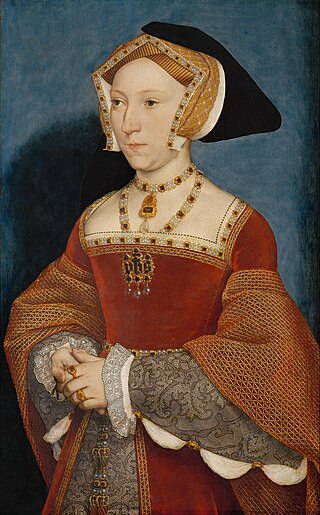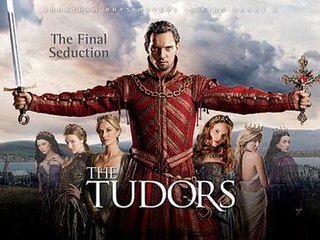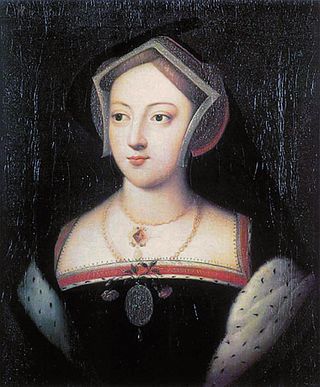
Jane Seymour was Queen of England as the third wife of King Henry VIII from their marriage on 30 May 1536 until her death the next year. She became queen following the execution of Henry's second wife, Anne Boleyn, who was accused by King Henry VIII of adultery after failing to produce the male heir he so desperately desired. Jane, however, died of postnatal complications less than two weeks after the birth of her only child, the future King Edward VI. She was the only wife of Henry to receive a queen's funeral; and he was later buried alongside her remains in St George's Chapel, Windsor Castle.

Anne of Cleves was Queen of England from 6 January to 12 July 1540 as the fourth wife of King Henry VIII. Not much is known about Anne before 1527, when she became betrothed to Francis, Duke of Bar, son and heir of Antoine, Duke of Lorraine, although their marriage did not proceed. In March 1539, negotiations for Anne's marriage to Henry began, as Henry believed that he needed to form a political alliance with her brother, William, who was a leader of the Protestants of Western Germany, to strengthen his position against potential attacks from Catholic France and the Holy Roman Empire.

Philippa Gregory is an English historical novelist who has been publishing since 1987. The best known of her works is The Other Boleyn Girl (2001), which in 2002 won the Romantic Novel of the Year Award from the Romantic Novelists' Association and has been adapted into two films.

Elizabeth Blount, commonly known during her lifetime as Bessie Blount, was a mistress of Henry VIII of England.
Retha Marvine Warnicke is an American historian and Professor of History at Arizona State University.

In common parlance, the wives of Henry VIII were the six queens consort of King Henry VIII of England between 1509 and his death in 1547. In legal terms, Henry had only three wives, because three of his marriages were annulled by the Church of England. He was never granted an annulment by the Pope, as he desired, however, for Catherine of Aragon, his first wife. Annulments declare that a true marriage never took place, unlike a divorce, in which a married couple end their union. Along with his six wives, Henry took several mistresses.

William Carey was a courtier and favourite of King Henry VIII of England. He served the king as a Gentleman of the Privy chamber, and Esquire of the Body to the King. His wife, Mary Boleyn, is known to history as a mistress of King Henry VIII and the sister of Henry's second wife, Anne Boleyn.

The Tudors is a historical fiction television series set primarily in 16th-century England, created and written by Michael Hirst and produced for the American premium cable television channel Showtime. The series was a collaboration among American, British, and Canadian producers, and was filmed mostly in Ireland. While named after the Tudor dynasty as a whole, it is based specifically upon the reign of King Henry VIII.

Henry VIII and His Six Wives is a 1972 British historical film adaptation, directed by Waris Hussein, of the BBC 1970 six-part miniseries The Six Wives of Henry VIII. Keith Michell, who plays Henry VIII in the TV series, also portrays the king in the film. His six wives are portrayed by different actresses, among them Frances Cuka as Catherine of Aragon, and Jane Asher as Jane Seymour. Donald Pleasence portrays Thomas Cromwell and Bernard Hepton portrays Archbishop Thomas Cranmer, a role he had also played in the miniseries and briefly in its follow-up Elizabeth R.

Thomas Burgh, 1st Baron Burgh also spelt Borough, KG, 1st Baron Borough of Gainsborough, also de jure 5th Baron Strabolgi and 7th Baron Cobham of Sterborough, was an English peer. In 1513 he was knighted on Flodden Field, where he was one of the King's Spears, a bodyguard of King Henry VIII. He later became Lord Chamberlain to Anne Boleyn. He was also one of the twenty-six Peers summoned to the trial of Anne Boleyn in May 1536.

Mary FitzRoy, Duchess of Richmond and Somerset, born Mary Howard, was a daughter-in-law of King Henry VIII of England, being the wife of his illegitimate son Henry FitzRoy, 1st Duke of Richmond and Somerset.
Alison Weir is a British author and public historian. She primarily writes about the history of English royal women and families, in the form of biographies that explore their historical setting. She has also written numerous works of historical fiction.

Elizabeth Carew was an English courtier and reputed mistress of King Henry VIII.

Mary Boleyn, also known as Lady Mary, was the sister of English queen consort Anne Boleyn, whose family enjoyed considerable influence during the reign of King Henry VIII.

Catherine Howard was Queen of England from 1540 until 1541 as the fifth wife of King Henry VIII. She was the daughter of Lord Edmund Howard and Joyce Culpeper, a cousin to Anne Boleyn, and the niece of Thomas Howard, 3rd Duke of Norfolk. Thomas Howard was a prominent politician at Henry's court, and he secured her a place in the household of Henry's fourth wife, Anne of Cleves, where she caught the King's interest. She married him on 28 July 1540 at Oatlands Palace in Surrey, just 19 days after the annulment of his marriage to Anne. He was 49, and she was between 15 and 21 years old, though it is widely accepted that she was 17 at the time of her marriage to Henry VIII.
Mary Fiennes (1495–1531) was an English courtier. She was the wife of Henry Norris. Norris was executed for treason as one of the alleged lovers of her cousin, Anne Boleyn, the second wife of King Henry VIII of England. Mary lived for six years at the French court as a Maid of Honour to queens consort Mary Tudor, wife of Louis XII; and Claude of France, wife of Francis I.

The mistresses of Henry VIII included many notable women between 1509 and 1536. They have been the subject of biographies, novels and films.
Henry VIII of England had several children. The best known children are the three legitimate offspring who survived infancy and would succeed him of England, successively, Edward VI, Mary I and Elizabeth I.
Sir Henry Seymour was an English landowner and MP, the brother of Jane Seymour, queen consort of Henry VIII, and consequently uncle to Edward VI. He was created a Knight of the Bath after his nephew's coronation.

Claire Ridgway is a British historian and author of books about the Tudor dynasty, with a particular focus on the life of the Boleyn family. Since 2009 she has run the websites TheAnneBoleynFiles.com and Elizabethfiles.com. In 2014, Claire founded The Tudor Society.














